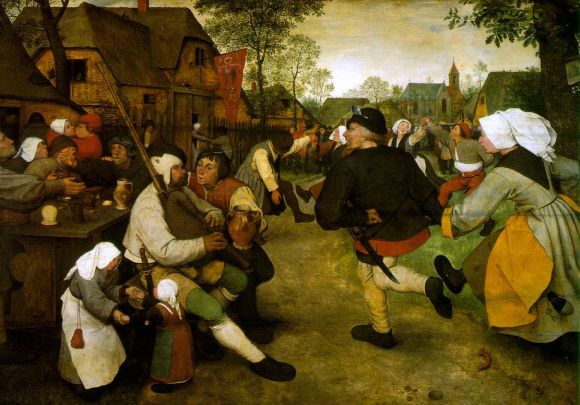
In Brueghel’s great picture, The Kermess,
the dancers go round, they go round and
around, the squeal and the blare and the
tweedle of bagpipes, a bugle and fiddles
tipping their bellies (round as the thick-
sided glasses whose wash they impound)
Finish reading The Dance here and then click the button to hear William Carlos Williams read the poem.
—William Carlos Williams, The Dance first published in Pictures from Brueghel and Other Poems (1962)
A kermesse was originally a special celebration on the feast day of the saint who stood as patron for the town or village in which it occurred. It was common in the southern Netherlands and in Flanders. Over time, however, the concept came to mark any special town or village oriented celebration, often organized to some charitable purpose, and indeed the concept of the kermesse made the jump across the Atlantic to Dutch and Flemish communities in the United States, in New York and Michigan, for instance. The painting by Brueghel the Elder (there is also one by Pieter Brueghel the Younger, which is not, however, nearly such a masterwork) is a record of the festivities of peasant society. It is a wonderful depiction of careless merriment, but it also records with meticulous detail the life of the time. One of the strange contradictions of Brueghel is that his works have an air of almost cartoonish simplicity about them, but then on closer inspection they turn out to offer extraordinary depth and detail. Williams tells us that they show the benefit of the Italian masters, which is certainly true. We know that Brueghel made the venture across the Alps, doing it in a time of great upheavel and hardship. He returned with a greatly improved sense of perspective, that is certain, and it’s likely he learned new secrets in the art of grinding and preparing pigments and their application to canvas and wood. But for all of that works like the Kermess show little from his Italian journey; they are very peculiarly Brueghel works and they show his spirit, his mind, his time and place.
We enter the holiday season this week, in a time beset with troubles on many fronts. This in fact is precisely what Brueghel is recording, and his works seem perfect for the season. This painting chronicles celebration against a backdrop of great anxiety, suffering and troubles. The people preserve their hope and show a determination to persevere. That is the timeless and uplifting message in this work.
And what tunes were they dancing to? In the middle of the sixteenth century, Brueghel was establishing himself as a master painter in Antwerp before he resettled in Brussels. There he almost certainly knew one of the town premier composers and publishers, who was at the time attempting to develop a business publishing prints and etchings to supplement his music publishing and may have published works of Brueghel. His name was Tylman Susato, and here the Renaissance Consort performs a short suite of dance tunes taken from his Danserye, published in 1551. Listen to the squeal and blare of the sackbutts, the screach of the fiddles.


